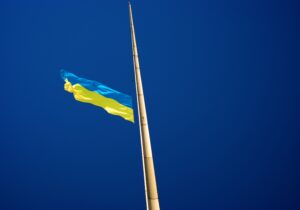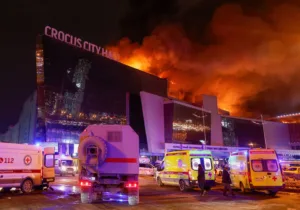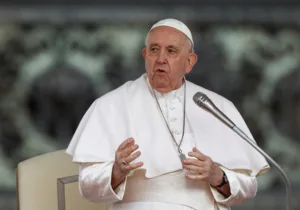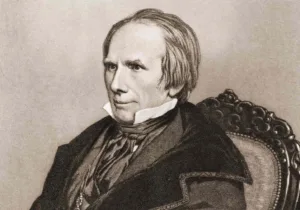The Ukrainian Conflict Is Reopening Old Wounds Across the Former USSR
In the Christian Syriac legend from late antiquity, Alexander the Great built a wall stretching across a narrow mountain pass in the Caucasus to keep out the peoples of Gog and Magog from his Greek empire. A modification of this story also survives in the Muslim tradition, in the figure of the mysterious unnamed “Two-Horned One” who builds a rampart against Gog and Magog at the behest of a beleaguered nation, which will last until the final days. To the Roman and Persian imagination, the Eurasian steppe north of the formidable Caucasus mountains represented a boundless frontier of open grassland.
The mountainous Kingdom of Armenia represented the northernmost frontier of both empires, and acted as a buffer state between them. Neither empire possessed much interest in penetrating the steppe mountain passes and facing the intimidating hordes of horse archers to its north. The first-century Jewish historian, Josephus, identifies Gog with the Sarmatians, a nomadic Iranian people living in modern-day Ukraine. Ambrose of Milan on the other hand connects Gog with the Goths, Germanic tribes who migrated from the interior of Eastern Europe into the Roman Empire, and carved up its territory as warlords. The Jewish, Christian and Muslim traditions understood the uncharted expanses of Central Asia and Eastern Europe to host the descendants of Japheth, the middle of Noah’s three sons. The etymology of Japheth’s name, “to expand” certainly applies to the vastness of one of the largest continuous grasslands on the planet. Noah incorporates a pun in Genesis, blessing his middle son to expand into the world. Armenian legends for instance connect their national founder Hayk as a descendant of Japheth. Only the Caucasus mountains defended the northern front of the classical civilizations to their south.
Another less well-known participant in the fall of the Roman Empire were the Alans. The Alans, like the Sarmatians, were a nomadic Iranian people who migrated west with the Gothic tribes to settle within the Roman Empire, expelled from their Eastern European homeland by the Huns. The Alans ruled as chiefs alongside their Germanic and Roman allies in Gaul, and the Roman general Aetius even used them as auxiliary forces to counter the Hunnic invaders under Attila. Other Alani tribes outside of the Roman Empire fled southeast away from the Huns in the Eurasian steppe into the western Caucasus mountains, a fortress against any opposing imperial powers to take away their freedoms. These Caucasian Alani tribes became the modern-day Ossetian people, an Eastern Orthodox people who still retain the Iranian language of their ancestors. In between the narrow mountain passes are fertile but small valleys sectioned off from each other. This allowed for the development of very unique and diverse peoples living simultaneously in close proximity and also in isolation to one another: including Georgians, Abkhazians, Armenians, Chechens, Ingush, Kurds, Talysh and Azerbaijanis. Today the territory is split among four (universally internationally-recognized) countries: Russia occupies the northern half, with the south divided between Georgia, Armenia and Azerbaijan. Most inhabitants, based on ethnicity, belong to the Eastern Orthodox Church, the Armenian Apostolic Church, Shii Islam or Sunni Islam, with smaller communities of Armenian Catholics, Yazidis and Jews.
Rome in the west fell at the end of the fifth century, and the Ottomans took Constantinople in 1453, leaving Moscow as the Third Rome in the Russian tradition. Where First Rome and Second Rome failed in securing the unruly mountain range, Third Rome succeeded under the nineteenth century Tsars. Over the course of a century, the Russians took the Caucasus piecemeal from the Ottomans and Qajar Iran. The fierce independence and multiplicity of these Caucasian peoples which daunted previous empires also proved a weakness. The Caucasian peoples could not provide a united front against the Russian advance, and all of the mountains were absorbed into the Russian Empire.
In the chaos following the end of World War I and the beginning of the Russian Civil War, freedom fighters resisting both the Ottomans to the south and Bolsheviks to the north established the short-lived Transcaucasian Democratic Federative Republic, a union of the various peoples of the North Caucasus in 1918. The Republic lasted less than a year however, when it collapsed into briefly independent Armenia, Georgia and Azerbaijan. Each independent Caucasian nation on its own failed to resist the upper hand the Bolsheviks gained against the various royalist factions, and took each one at a time. By 1922, the three republics were organized as the Soviet Transcaucasian Federation until 1936, when Stalin reorganized the southern Caucasus into the Georgian, Armenian and Azerbaijani Soviet Socialist Republics. He did not grant independent Soviet Republics to the Chechans or Ingush peoples to the north, however he did grant them autonomy as an “autonomous soviet socialist republic” within the Russian S.S.R. He also granted a similar status to Dagestan and North Ossetia. In the case of North Ossetia, he split the Ossetian people in half, establishing the North Ossetian A.S.S.R in Russia, but the South Ossetian A.S.S.R. in Georgia. This division encouraged a destabilized Georgia, almost guaranteeing civil ethnic strife in the event Georgia ever seceded from the Soviet Union and tethered the divided Ossetian nation to Moscow to retain its unity. The Soviet meddling in Georgia is ironic given Stalin’s ethnic origin as an ethnic Georgian; doubly ironic as well, given the public Soviet rebuke of European colonialism while employing the same methods in the Caucasus as London and Paris did in sub-Saharan Africa.
The Soviet Union did collapse however, and Stalin’s long term strategy worked according to plan in the South Caucasus. The territorial disputes over South Ossetia, Abkhazia and Nagorno-Karabakh led to the deaths of hundreds of thousands of Georgians, Armenians and Azerbaijanis in the 1990’s. While this allowed the Russians to intervene to their benefit in the south, in the North Caucasus Boris Yeltsin could not prevent the independence of Chechnya in 1992. Only after the Second Chechen War was Chechnya reabsorbed into the Russian Federation by Vladimir Putin at the cost of hundreds of thousands of Chechan lives and the majority of Russians in Chechnya. Putin only succeeded in tempering Chechan independence in 2009 by installing his ally Ramzan Kadyrov as head of the government. Chechnya like many other Muslim-majority ethnic republics in Russia has broad autonomy within their borders, similar to the A.S.S.R’s in the Soviet Union. Kadyrov sent troops under his own personal command to Ukraine as part of a vanguard to take Kyiv.
Many Chechans in exile on the other hand choose to fight alongside the Ukrainian army against their pro-Moscow counterparts. Members of the Sheikh Mansur and Dzhokhar Dudayev Battalions who fled from Chechnya fight against the Kadyrovsky- units loyal to Kadyrov- on Ukrainian soil. On October 18, the Verkhovna Rada (Ukraine’s parliament) recognized the Chechan independence and labeled Russian atrocities against Chechens as a genocide. This gesture remains largely symbolic, as Ukraine is the only country in the world to recognize Chechen Republic of Ichkeria as an independent nation. It does, however, repay the favor to Chechens fighting for Kyiv who are doing so largely for their own national ambitions.
The conduct of the war has exposed chinks in the pro-Russian Chechen war effort. While Kadyrov still holds a firm grip on Chechen society and keeps the region loyal to Putin, the longer the war continues, the weaker Moscow’s ability to govern the republic becomes. Other republics have encountered stiffer resistance from Moscow than Chechnya, especially after the announcement of a partial mobilization of over 300,000 recruits. Despite ostensibly holding the most autonomy within Russia, the ethnic republics believe they have been disproportionately selected for the recent draft, including Buryatia in Siberia, and Dagestan, another Muslim-majority republic in the South Caucasus. In Dagestan, authorities had to detain protesters who organized against the mobilization efforts.
In the Republic of Bashkortostan, an insurgency may be underway, as unknown assailants firebombed Russian military offices to prevent the drafting of more men. A leader of the Bashkir independence movement in exile, Ruslan Gabbasov, took credit. The fragile peace the Russian Federation has experienced in the last thirty years by granting autonomy to its ethnic minorities may unravel under the strains of an ever-increasingly unpopular war. The Balkanization of the world’s largest nuclear arsenal could provoke a potentially apocalyptic scenario. Goaded on by Ukraine and other countries, the ethnic minorities of Russia may break through Alexander’s Wall in the Caucasus.






 Sponsor a student for Christianity & National Security 2024
Sponsor a student for Christianity & National Security 2024